|
Prominent people from past times
- AND MANY OF THOSE
WHO ARE LESS WELL-KNOWN
|
 |
HEREWARD THE WAKE (flourished
1070) lead the Saxon uprising against the invaders after the Norman
Conquest of 1066 although little factual information about his life
survives. There seems no doubt that he did cause problems for the
Normans but his reputation rests mainly with the many fictional
accounts of his exploits, particularly the colourful descriptions of
him ridding Bourne of the invading army while the story of his death
in Bourne Wood at the hands of the enemy is undoubtedly apocryphal. |
|
ROBERT MANNING
(1264-1340) is perhaps the most notable of all our citizens in
that he is credited with putting the speech of the ordinary people
of his time into the recognisable form that we have today. He is
best known as Robert de Brunne because of his long time residence
as a canon at Bourne Abbey where he completed his life's work and
in the process, popularised religious and historical material in a
Middle English dialect that was easily understood by the people of
his time. His best known work was Handlyng Synne, a book of
great value because it gives glimpses into the ways and thoughts of our countrymen 600 years ago and even more, shows us the language then in common use. |
|
ORM THE PREACHER
(flourished 1180) also worked at Bourne Abbey a century
earlier than Robert Manning but his presence here has only been
revealed during recent research. His homily collection known as The
Ormulum has been well known to linguists and language historians ever since the 17th century but its source has
only recently been established as Bourne Abbey. Orm's language provides a glimpse of the English vernacular of the time and before it was strongly influenced by the French. It is assumed that the manuscript remained at Bourne Abbey until the dissolution of the monasteries between 1536 and
1540 and after various owners, is now in the Bodleian Library at
Oxford University.
|
|
WILLIAM CECIL
(1520-1598)
became the first Lord Burghley after serving Queen Elizabeth I for
forty years, during which time he was the main architect of
Britain's successful policies of that period, earning a reputation as a master of renaissance statecraft
with outstanding talents as a diplomat, politician and administrator.
He was born at a house in the town centre at Bourne that is now
the Burghley Arms and a plaque on the outside reminds us of this
event. |
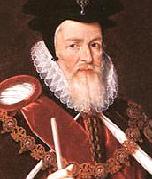 |
|
|
JOB HARTOP (1550-1595)
was a farmer's boy working on the land near Bourne but hankered
after a life of adventure and ran away to sea when he was 12
years old. After a short apprenticeship with a gunpowder
manufacturer in London, he signed on with the English admiral Sir
John Hawkins and sailed the Spanish main in the company of the
young Francis Drake. He was captured by the Spanish on his third
voyage and spent ten years as a galley slave and thirteen years in
a Spanish prison but managed to escape and make his way back
to Bourne where he spent his final days recounting his adventures in
the town's taverns, although the privations he suffered had taken
their toll and he died at the age of 45.
WILLIAM
TROLLOPE
(1562-1637) was a prominent
landowner whose ancestors settled in the Bourne area from County
Durham in the mid-16th century and who increased his fortune
considerably through land acquisition but became one of our most
eminent philanthropists. He left two important bequests in his
will, firstly an endowment to establish a free grammar school
which marked a new important phase in local education for the town
and secondly sufficient money to build almshouses for six poor,
aged men. Both properties survive today although largely rebuilt. |
|
ROBERT
HARRINGTON (1589-1654) made large bequests to Bourne from
which the community benefits to this day. Legend has it that he
walked to London to seek his fortune and was most successful in
his endeavours and when he died, he remembered his home town by
leaving shops and dwelling houses in the Leytonstone area
"for the benefit of his own people", namely the citizens
of Bourne. The charity established in his name is by far the
greatest currently administered by Bourne United Charities and
fittingly, Harrington Street was named in his memory. |
Dr WILLIAM
DODD (1729-1777), was an Anglican clergyman, a man of
letters and a forger. He was the son of the Rev William Dodd,
Vicar of Bourne from 1727-56, graduating with distinction from
Clare College, Cambridge, and then moved to London where his
extravagant lifestyle landed him in debt and worried his friends
who persuaded him to mend his ways and so he decided to take holy
orders and was ordained in 1751. He became a popular and
fashionable preacher but was always short of money and in an
attempt to rectify his depleted finances, forged a bond in the sum
of £4,200. He was found out, prosecuted and sentenced to death and
publicly hanged at Tyburn on 27th June 1777. |
BRYAN BROWNING (1773-1856),
the architect, is best remembered for his design of Bourne Town
Hall, built in 1821 by public subscription and still in use today.
He was also responsible for the House of Correction at Folkingham
and the workhouses at Bourne, Stamford and Spalding. Browning was
a dedicated villager whose family made their mark on Thurlby over
a period of two centuries and several members of his family are
buried in the churchyard. |
JOHN LELY OSTLER
(1811-1859)
was born into a distinguished family at
Grantham who claimed the celebrated 17th century Dutch artist Sir
Peter Lely as an ancestor. He did not move to Bourne until a few
years before his early death at the age of 48 but in that time, he
became one of the biggest land and property owners in the
district, supporting charitable causes, including schools. Such
was his reputation, that an elaborate monument was erected in the
market place in his memory and can still be seen in the town
cemetery. |
|
ROBERT MASON MILLS
(1819-1904) realised the market potential of the fresh water
supply freely available in Bourne and extracted it from underground springs and
sold it world-wide.
His aerated water business became part of the town's prosperity
during the 19th century, giving employment to many and earning his
business a Royal Warrant for supplying Queen Victoria's son, the
Duke of Connaught, who bought it for its medicinal and
health giving qualities. |
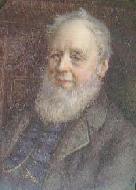 |
|
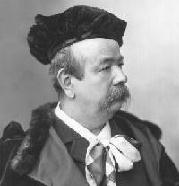 |
CHARLES WORTH
(1825-1895), son of a local solicitor, was born at Wake House,
North Street, now used as a community centre. He left
Bourne when still a boy to seek his fortune in Paris where
he became a world renowned designer of women's fashion and the
founder of haute couture. His reputation was such that the
French government awarded him the Legion of Honour and when he
died, 2,000 people, including the President of the Republic,
attended his funeral. |
|
|
SIR GEORGE WHITE (1840-1912) was a cobbler's son
who was born above his father's shop in West Street, Bourne, and
left home at 16 to work at a boot and shoe factory in Norwich but soon
made his mark in business, the Baptist movement and in public life,
becoming an alderman and Sheriff of Norwich and later M P for North West
Norfolk, a seat which he held for twelve years until his death at the age
of
72. He was knighted for his public service in 1907. |
WILLIAM WHERRY
(1841-1915) was one of the most unselfish men to serve this town. He
thought so much of his fellow man that he continually strived to
make life better and the burden he took upon himself might well have hastened his end. He was forced to retire from public life because of ill health at the age of 74 when his numerous offices and positions of responsibility numbered almost 100.
If Bourne needs an example of a man of stature, then he is the
one. |
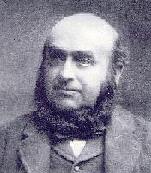 |
|
 |
ROBERT A GARDNER (1850-1926)
was a bank manager in Bourne and also a talented artist whose work
was exhibited in the Royal Academy. He never aspired to public
office but his interest in the community inevitably resulted in a
number of appointments, notably as a magistrate and chairman of the
Bourne bench. But he is best remembered for his paintings and many
of his works survive to this day, mostly in private ownership
although some can be found hanging in the Red Hall. |
|
FREDERIC MANNING (1882-1935)
wrote what is considered to be one of the finest novels dealing
with the Great War of 1914-18 and much of this work was completed
while staying at the Bull Hotel in Bourne, now the Burghley Arms.
Manning was an Australian who chose to live here after a spell at
Edenham where he stayed with the vicar, the Rev Arthur Galton, who had been his tutor. Her Privates We was
at first published anonymously, to much critical acclaim, but
eight years after his death, it was published in 1943 under his
own name and is still in print almost 70 years later. In the book,
Manning acknowledged his affection for this town by calling his
hero Private Bourne. |
|
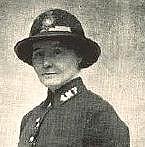 |
LILIAN WYLES
(1885-1975) was a major
influence in the acceptance of women into the police force.
She was the only daughter of the Bourne brewer, Joseph Wyles,
and after a spell of duty on the streets of London with the
new women patrols to assist young girls at risk, was
promoted inspector in 1922, becoming the first woman officer
of the Metropolitan Police's CID department |
|
CHARLES SHARPE
(1889-1963)
was a farmer's boy from Pickworth, near Bourne, who ran away from
home and joined the army. During the Great War of 1914-18, an act
of conspicuous bravery earned him the Victoria Cross, Britain's
highest decoration for valour, and he subsequently inspired many
young men to enlist. On return to civilian life, he
worked at a number of jobs, notably as a physical training
instructor to boys at the Hereward Camp approved school who
regarded him as a role model. |
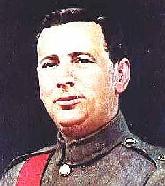 |
|
|
 |
HORACE STANTON (1897-1977), a local solicitor, gave a lifetime of service to this town
and it is to him that we are indebted for the War Memorial and its
gardens and the Abbey Lawn. He also commanded the district's Home
Guard detachment during the Second World War. There were few
aspects of life in the town that he did not influence and the high
esteem in which he was held was echoed at his funeral service when
the vicar, the Rev Gordon Lanham said: "If you would see his monument, look
around." |
|
Dr JOHN (ALISTAIR) GALLETLY
(1899-1993) was a general practitioner of
the old school who gave medical advice and dispensed medicine to
the inhabitants of this town from his surgery in North Road for
more than 40 years. He was also one of the most respected and
interesting characters to live in Bourne and when he retired in
1969, tributes were paid to his dedicated work as the town's most
eminent family doctor. |
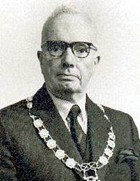 |
|
 |
RAYMOND MAYS (1899-1980)
achieved fame in the world of international
motor racing, on and off the track. After a successful
career as a driver, he opened workshops in Bourne where he
developed the BRM, the revolutionary car that eventually became
the first all-British model to win the world championship in 1962. Mays,
who lived at Eastgate House in Bourne all his life, was honoured with a CBE in 1978 for his services to motor
racing. |
|
LORENZO WARNER
(1901-1995)
started his working life as a newspaper delivery boy but the business he founded continues
in Bourne today as Warners Midlands plc, one of the most prestigious printing companies in
the East Midlands and still run as a family concern.
He was also active in many areas of community life including the Methodist Church, Bourne Cricket Club and Bourne Urban District Council,
becoming their chairman for the year 1970-71. |
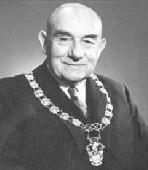 |
|
|
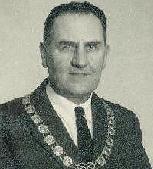 |
JACK BURCHNELL
(1909-1973) was among the last of the old style councillors who
put the people before personal gain and reputation. He devoted more
than a quarter of a century to this town and was responsible for
instilling a new sense of pride in the community by supporting
both the Civic Sunday and the Civic Ball, events that survive
to this day, as well as saving the Red Hall which would have been demolished but for his intervention. |
|
Illustrated
biographies of all those mentioned above
may be found on
the CD-ROM
A Portrait of Bourne
|
Other lives profiled on the CD-ROM are those
of |
Ron Alexander
(1920-1998)
The Earl of Ancaster (1907-1983)
John Robert Arnold (1885-1965)
Geoffrey Atkins (1930-1990)
Thomas Whyment Atkinson (1874-1954)
William Bampton (1787-1830)
Harry Barker (1923-2008)
Harry Barnatt (1881-1977)
Thomas Barsby (1840-1918)
Terry Bates (1936-2009)
Thomas Moore Baxter (1854-1920)
Cecil Walker Bell (1868-1947)
George E Bett (1913-56)
George Bettinson (1819-1885)
Clarence Binns (1897-1975)
Malcolm Boggitt (1940-2008)
Howard Bostock (1924-98)
Henry Bott (1810-1888)
Cuthbert Bradley (1861-1941)
Grace Bristow MBE (1910-87)
Edward Browning (1816-1882)
Mary Ann Buckberry (1817-1916)
James Watson Burdwood (1837-1916)
Henry Burtt (1892-1987)
Trissie Carlton (1907-1999)
The Rev James Carvath (1854-1929)
Reg Chapman (1912-1979)
Maria Christian (1855-1921)
Edward Clark (1866-1938)
Marjorie Clark (1919-2007)
Cyril Clay BEM (1923-2012)
Everitt D Cooke (1895-1964)
Kate Cooke MBE (1896-1978)
Kath Cox (1911-2008)
Joseph J Davies (1856-1920)
L R W Day (1900-1989)
Thomas Deacon (1788-1860)
Louis Decamp (1919-99)
Catherine Digby (1773-1836)
The Rev Joseph Dodsworth (1797-1877)
John Dove & family (fl. 18th-19th Century)
Mrs Pat Edmunds (1914-2008)
Joseph Ellicock (1842-1909)
John Evans (1817-1899)
Charles Everard (1847-1907)
Don Fisher (1933-2011)
Joseph Tye Flatters (1841-1885)
Ernest Foley (1868-1926)
William Redmile Garner (1841-1928)
Geoffrey of Bourn (fl. 1292-1303)
Richard Boaler Gibson (1879-1958)
William Gibson (1849-1885)
Dr John Gilpin MBE (1864-1943)
Thomas Glendening (1838-1899)
James Goodyear (1810-1871)
John Grummitt (1912-72)
Sir Edward Harwood (1586-1632)
Sir Maurice Heath (1909-1998)
William Hemsell (1898-1959)
Frederick Hinson (1837-1910)
Thomas Hinson (1816-1902)
Cecil Thomas Hodgkinson (1898-1979)
Dr George Holloway (1905-1967)
The Rev Samuel Hopkinson (1754-1841)
Edwin Barnett Horn (1914-2005)
The Rev Charles Horne (1876-1951)
Jeremiah Ives (1692-1741) |
John Jackson (1585-1612)
William Augustus
Johnson (1777-1863)
Tom Jones (1915-1993)
Edgar Judge
(1862-1951)
Henry Kelham
(1845-1916)
George William Knipe (1917-1995)
John Layton (1831-1905)
Sir Kenneth Lewis (1916-97)
Tom Lyall (1895-1967)
Charles Mapperson (1830-1918)
Charles Pask Matthews (1886-1956)
The Mawby family (fl.1780-1890)
George Henry Mays (1859-1926)
Thomas William Mays (1856-1934)
Viscount Midleton (1903-1988)
Jack Moody BEM (1906-1992)
Frederick Nash (1858-1926)
Oger the Breton (fl. 1086)
Mary Parker (1926-2004)
Colonel William Parker (1824-1909)
Richard Newton Pattison (1879-1959)
John Peacock (1839-1922)
John Thomas Pearce (1852-1905)
Thomas Pearce (1820-1919)
Arnold Pick (1845-1891)
Eric Pick (1925-2012)
Ida Pick MBE (1888-1975)
Thomas Leonard Pick (1909-2004)
Thomas Pilkington (1800-1889)
Pochin family (fl. 18th-19th Century)
Thomas Rawnsley (1755-1826)
Jane Redmile (1800-1883)
William Redshaw (1856-1943)
Douglas Reeson (1918-2010)
Richard Reeve (1936-1987)
Thomas Rickard (1865-1931)
Harry Ringrose (1881-1979)
George Ernest Robinson (1901-2000)
Arthur Saul (1856-1920)
Dick Sellars (1920-2010)
Robert James Shilcock (1823-1908)
John Baxter Shilcock (1850-1927)
Annie Shillaker (1862-1937)
Harry Shillaker (1865-1924)
Hugh Delaine-Smith MBE (1920-95)
Harry Garwood Sneath (1887-1979)
Henry Andrews Sneath (1860-1931)
Lewis Sommerfield (1924-2012)
Frederick Sones (1871-1934)
Alfred Stubley (1859-1932)
Ashby Swift (1882-1941)
John T Swift (1855-1939)
Charles Tennyson (1784-1861)
Florence Tipler (1905-1986)
George Walter Todd (1873-196)
James Toulson (1869-1954)
Trollope family (fl. 16th-20th Century)
William Walpole (1843-1907)
Albert E K Wherry OBE (1874-1962)
Sir George White (1840-1912)
Dr Francis Willis (1718-1807)
Lawrence Percy Wilson (1918-2005)
Harold Withers (1904-1986)
Norma Woolley (1934-2007)
John Worsdall (1842-1923)
William Worth (1789-1878)
John Henry Wright (1919-2010) |
|
MORE BRIEF
BIOGRAPHIES INCLUDE
Edward Andrew, Thomas Ball, J W E (Bill) Banks, Dr George Blasson, William Bradley,
John Branston, Willerton
Brown, Mary Buckberry, Joseph Burn, John Campbell, William Castledine,
Frederick Clarke, Ray Cliffe, George Collinson, Albert Dainty, Harry Dowsett, Leslie Ferriby,
James Edward Fisher, Reginald Foster, Eve Frazer, Henry Goodyear, Harry Goodyer,
Roland Green, Edward Grummitt, William
Hall, John Hinson, Hugh and Susannah Hobson, William
Kingston, William Lister, John Lunn, Hugh Mansfield, John Mansfield, Jean McKenzie, Thomas Measures, Birt Morris, George Octavius Munton, William
Nowell, Frederick John North, Joshua North,
William Pearce,
Stanley Pease, Thomas Pick, William Earle Pick, John Pool, Thomas Revill, Eric Rickard, John Roberts, Eunice Rogan, Tony Rudd, William Scott, Thomas Shippey,
Hannah Smith, Reg Sones, Ernest Spridgeon, Alec Stokes, Edward
Stringer, Basil Stroud, Stuart Stroud, Henry Stubley, Cecil Sweetnam,
Edward Trollope, George
Tory, William and Annie Townson,
Joseph B Walker and William Welldon. |
|
LETTERS FROM THE FRONT - THE BOER WAR OF 1899-1902
This includes information about
Trooper Emminson Bell, Private Edward Cliffe, Private George
Cornwall, Driver Joseph Dickens, Private George Drakard, Trooper
George Franks, Private William Glenn, Quarter-Master
Sergeant Harrison, Lance Corporal Herbert Marsh, Private A
Percival, Lance Corporal H Leslie Pike, Private Bennett Rogers*,
Gunner Charles Stuffins, Private S Tipler* and Private George
Tyers.
(* Denotes later killed in action). |
|
LETTERS FROM THE TRENCHES - THE
GREAT WAR OF 1914-18
This includes correspondence from
Private Albert J Adamson, Private John Bannister, Private Martin
Barnes, Private Vernon Bradley, Private Ernest Bull, Private
Joseph Bullimore, Lance Corporal Oliver Davies, Private Victor
Davies, Private W Davies, Private Fred Fisher, Trooper Fred
Flatters, Gunner Charles Garfoot, Gunner Edward Garfoot, Private
Stephen Grummitt, Driver Fred Hinson, Private W Lane* (letter of
condolence), Sergeant Cedric W Lloyd, Private Percy Lunn, Private
Percy Milan, Private E Moisey, Sapper George North, Private T
Phillips, Private Harold Robinson, Private George Sherwin*, Lance
Corporal H H Steel, Private J Stevenson*, Private S Tipler, Lance
Corporal Percy J Vickers, Private W Watts*, Corporal Arthur
Webster, Private J W Wyles and Sergeant F A Yates.
(* Denotes later killed in action). |
|
CRIME AND PUNISHMENT - CASES FROM PAST TIMES
Andrew R Agnew, Mary Atkinson, John
Baker, John William Beck, Joseph Bellamy, Joseph Bland, William
Bradley, Richard Brightman, Charles A Brown, Frederick Brown, John
Burbidge, John Burton, William Cartwright, Ada Clark, James
Clarke, Mark Clay, William Colby, Jane Crampton, William Downes, Elizabeth
Faulkner, Nicholas
Fowler, John Gibson, John Grummitt, Joseph Haddon, Sarah Jane
Halford, Henry Handley, William Hardwicke, James Harris, Thomas
and Anna Hilton, Richard Jackson, Elizabeth Johnson, Frank Jones, Eleanor Kelly,
Albert Kettle, George and Mary Kyme, John Lawson, William Henry
Marshall, William Edward Matthews, John Modd, Frank Newcombe,
Joseph Ogden, George and Charlotte Parker, William and Jane
Pheasant, Alfred Lawrence Platt, William Reeve, Frederick Rouse,
John de Rowe, Thomas Seerle, John and Charlotte Smith, Rose Sneath,
John Starkey, William Thiselton, Fred Vickers, Frederick Walker, Thomas Wallis,
Judith Weaving, Elizabeth Whitfield, Priscilla Woodward and James Wyles. |
|
TRANSPORTATION TO THE COLONIES IN THE 18TH AND 19TH CENTURIES
Francis Allam, Abraham
Atkins (alias William Matkins), Henry Barnes (alias Barns and
Baines), Davy Bennett, Thomas Bennett (alia Tuck), James Brown
(alias Baker), John Buck, Augustine Chamberlain, Perkins Cobley,
John Close, William Cox, William Crust, Henry Dawson, Robert
Elderkin, Ephraim Francis, George Gardiner, Mary Glenn, James Gray,
William Haxey, James Johnson, William Knight, Edward Marvin, Sarah
Marvin, John Marvin, John Moisey, Thomas Moisey, Charles Pell,
Charles Pinfold, Samuel Preston, John Roberts, Susannah Rogers,
William Scott, William Shaw, John Simpson, Thomas Sims, John
Stapleford, Joseph Stimson, Thomas Stimson, John Stubley, John
Thompson, Henry Thorpe, William Wells and John Whitacre (alias
Whitaker). |
|
THIS MORTAL COIL - BIZARRE AND UNEXPECTED DEATHS IN PAST TIMES
Henrietta Arden, Hugh Arnold, Millie Asher, Rebecca Bains, Jane Barwiss, Frances Sarah
Bellamy, Thomas Booth, John Boyer, Sarah Bromley, Emma Bullymore, Mary Burton,
Tom Cunnington, Ethel Darnes,
John Dring, Joseph Eason, William Elston, Thomas Fletcher, George Foulds, Rachel Gedney, Elizabeth
Gillson, Mary Green, James Griffin, Naomi Grummitt, George Hardwick, Samuel
Harvey, John
Meredith Hazelgreave, A Hewitt, the Rev John James Hodgson,
Charlotte Hubbard, John Hudson, Edward Jackson, Maurice Jackson,
Michael George Joyce, Thomas Kitchen, Frank Lank, Rose Ellen Makings, Digby
Marsh, James Measures, Joseph Measures, Edward Munton, Mary Ann Musson, Mary Elizabeth Nicholls, Ann Nixon, Joseph
Norman, William Norman, John Northern, John Osgothorpe, James
Arthur Parker, Charles Pick, Robert Pickering, Ernest Woodward
Pocklington, John Pullen, Campain Redmile, William Reed, James Rice, John
William Rix, Edward Robinson, William
Rodgers, Eleanor Rose, John Sandall, Lewis Sardeson, Albert Saxby, John Scotney, Josiah Sharpe,
Thomas Shelton, Charles Smith,
Clara Jane Smith, Helen Phyllis Smith, Thomas Smith, Thomas
Stevenson, Henry Stubley, May Victoria Stubley, William Sturges, Ann Thurlby,
William Todd, Mary Twitchell, John Usher,
Thomas Wilkinson, James Wilson, Albert Woolley and James
Young. |
|
A MEDICAL CASEBOOK -
UNUSUAL CASES IN PAST TIMES
Priscilla Boor, Henry Greenwood, Elizabeth Gunn, Henry Hewerdine, Edward Hubbard,
William Marriott, Charles Moisey, John Morris, Marie Nicholls,
William Palmer, Susannah Esther Pepper, Martha Pullen, Thomas
Redmile, W H Richards, Betsy Rouse, Samuel Smith, William
Todd and
Arthur Young. |
|
![]()